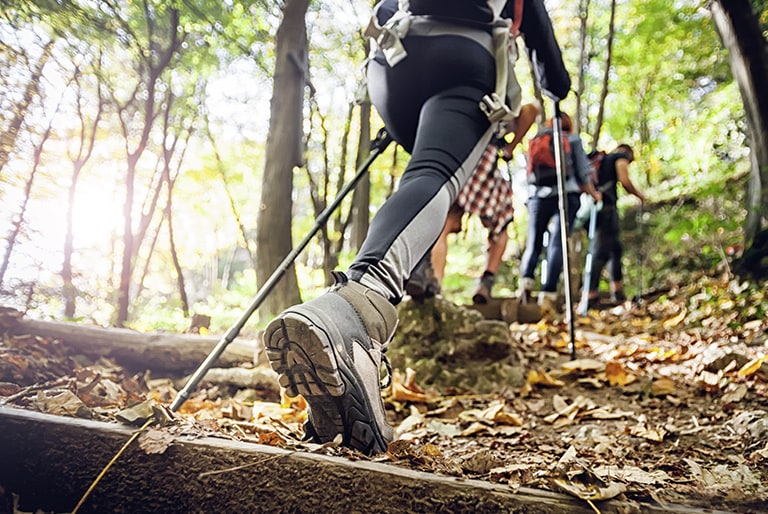Preventing varicose veins
Once varicose veins are visible they can only be removed by a surgical operation. That is why early prevention is the best method, in order to strengthen your vein functionality and to go through life with beautiful legs.

What causes varicose veins?
The thought of varicose veins causes panic with many people – especially women – because nobody wants the clearly visible, protruding, bluish veiny streaks on their legs. A quick look at your own, smooth legs provides a little bit of reassurance. But that can change over time!
Before varicose veins become visible, there have been many years of venous insufficiency, which often remains unnoticed and whose cause is usually weak connective tissue. When the varices one day appear it is usually too late, because varicose veins can no longer be reversed without surgery.
That is because over a long period the veins have not transported enough blood out of the legs upwards towards the heart. If more blood continues to build up in the lower extremities, the vein walls gradually expand and lose elasticity. At the same time, the venous valves no longer seal correctly and allow the blood which has been pumped upwards to flow back down. The expanded veins protrude as varicose veins under the surface of the skin and are considered by many to be very unsightly. Sometimes they also harbour an increased risk of vein thrombosis and vein inflammation.
What young women quite often do not know: the hormonal change during a pregnancy and the increased body weight also encourage varicose veins. Prevention and strengthening your veins in your younger years is the top priority so that it does not get that far.
How can I prevent varicose veins?
Varicose veins are usually a visible sign of chronic venous insufficiency. When you implement the following preventive measures you are thereby generally preventing venous diseases and strengthening the health of your veins:
- Lots of exercise: the best way for you to prevent varicose veins is to exercise. A sedentary lifestyle may appear very cosy to us, but for your veins sitting and standing are the best conditions for venous diseases, such as varicose veins or even vein thrombosis. So structure your day with as many bouts of exercise as possible. Regular sport, strolls, walking up stairs and, when time is short, at least vein gymnastics, which can be carried out on the side, should all not be mere exceptions. Always remember: the muscle pump is the impulse for blood flow from your legs upwards towards your heart. But to do that your muscles have to be active.
- Put your feet up: the build-up of blood can be dissolved by putting your feet up. Feet on a chair, on the table, against the wall or simply in the air – as a result the blood can flow more easily out of your legs towards your heart and your veins do not have to do all the hard work on their own.
- Drink enough: it is really hard to pump thick blood upwards against gravity. So keep your blood nice and fluid by taking in enough fluids. The more fluid your blood, the better will be the circulation in your body.
- Lose excess weight: a healthy diet is also the foundation for healthy veins. Excess weight and an unhealthy diet conversely encourage the development of varicose veins and other venous problems. Fresh fruit and vegetables and whole food products should be a part of your daily menu. In addition to that, reduce unhealthy fats, sugar and salt. Instead, you can season as you wish with herbs and spices.
- Contrast shower every day: cold, warm, cold, warm – the change in temperature trains your veins, which contract in the cold and expand again in the heat. Regular contrast showers keep your veins stable and elastic, so that they can effectively convey the blood upwards out of your legs.
- Medicines: the fluidity of your blood can also be improved with medicines. The active ingredient Troxerutin contained in Veno SL® 300 stabilises your fine blood vessels, which quickly become brittle if you have venous disorders. It also counteracts the formation of oedemas, which often develop in the legs when you have varicose veins.
- Compression therapy: the whole point of compression therapy is to support your veins with external pressure. The most well-known method are compression stockings, which can be worn to prevent varicose veins, in order to relieve your veins as best as possible and to prevent your vein walls from expanding.
- In order to recognise vein weakness early on pay attention to symptoms such as swollen legs, heavy legs, pain in the legs, nightly calf cramps or spider veins.
If such symptoms are not an isolated case and keep reoccurring, it is advisable that you consult a doctor and have your vein functions examined. The earlier diseases of the vein are recognised, the better after-effects such as varicose veins can be prevented or at least delayed with a targeted therapy.